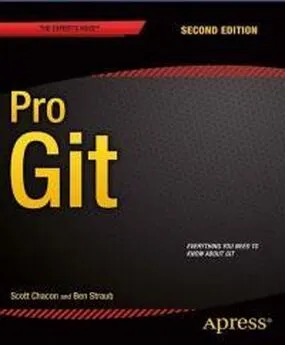Скотт Чакон - Pro Git
- Название:Pro Git
- Автор:
- Жанр:
- Издательство:неизвестно
- Год:неизвестен
- ISBN:нет данных
- Рейтинг:
- Избранное:Добавить в избранное
-
Отзывы:
-
Ваша оценка:
Скотт Чакон - Pro Git краткое содержание
В книге рассматриваются следующие темы: основы Git;
ветвление в Git;
Git на сервере;
распределённый Git;
GitHub;
инструменты Git;
настройка Git;
Git и другие системы контроля версий.
Pro Git - читать онлайн бесплатно полную версию (весь текст целиком)
Интервал:
Закладка:
#! /usr/bin/env ruby
data = STDIN.read
last_date = `git log --pretty=format:"%ad" -1`
puts data.gsub( '$Date$' , '$Date: ' + last_date.to_s + '$' )
Всё, что делает скрипт - это получает дату последнего коммита с помощью команды git log, заменяет результатом все подстроки $Date$ и возвращает результат. Вы можете написать аналогичный скрипт на любом языке. Назовите файл со скриптом, например, expand_date и сохраните в директории с программами. Теперь, нужно настроить Git фильтр (назовите его dater) и укажите ему использовать ваш скрипт expand_date при извлечении файлов. Всместе с этим, мы будем использовать регулярное выражение Perl для очистки перед коммитом:
$git config filter.dater.smudge expand_date
$git config filter.dater.clean 'perl -pe "s/\\\$Date[^\\\$]*\\\$/\\\$Date\\\$/"'
Указанная Perl команда очищает любое значение в строке, где она видит $Date$, чтобы вернуть файл в изначальное состояние. Теперь фильтр готов и вы можете проверить его добавив ключевое слово $Date$ в файл и настроив Git атрибут, чтобы для вашего файла применялся созданный фильтр:
$echo '# $Date$' > date_test.txt
$echo 'date*.txt filter=dater' >> .gitattributes
Если добавить в коммит последние изменения, а затем извлечь файл, то вы увидите корректную подстановку ключевого слова:
$git add date_test.txt .gitattributes
$git commit -m "Testing date expansion in Git"
$rm date_test.txt
$git checkout date_test.txt
$cat date_test.txt
#$Date: Tue Apr 21 07:26:52 2009 -0700$
Как вы могли заметить, описанный подход предоставляет большие возможности. Однако, вам стоит быть осторожным, так как файл .gitattributes включается в коммит и распространяется вместе с проектом, а драйвер (в данном случае dater) нет, поэтому он не будет работать везде. Учитывайте это при разработке фильтров оставляя возможность работы без них - так вы сохраните проект в рабочем состоянии.
Экспорт репозитория
Атрибуты Git так же позволяют вам делать некоторые интересные вещи при экспорте вашего проекта.
export-ignore
Вы можете указать Git игнорировать определенные файлы и директории при создании архива. Если в вашем проекте есть файл или директория, которые вам нужны, но вы не хотите включать их в архив при экспорте, то можно присвоить им атрибут export-ignore.
Например, у вас есть неколько файлов в директории test/ и совершенно нет смысла включать их в архив вашего проекта. В этом случае достаточно добавить следующую строку в файл .gitattributes:
test/ export-ignore
Теперь, при создании архива проекта командой git archive, директория test/ не будет включена в архив.
export-subst
При создании архива так же доступна простая подстановка по ключевым словам. Git допускает размещение строк $Format:$ в любом файле с любой комбинацией --pretty=format кодов, большинство из которых вам известны по Разделу 2. Например, если вы хотите добавить файл с именем LAST_COMMIT, в который будет добавляться дата последнего коммита при создании архива, то сделайте следующее:
$echo 'Last commit date: $Format:%cd$' > LAST_COMMIT
$echo "LAST_COMMIT export-subst" >> .gitattributes
$git add LAST_COMMIT .gitattributes
$git commit -am 'adding LAST_COMMIT file for archives'
Теперь, при создании архива проекта командой git archive, в него будет включен файл со следующим содержанием:
$cat LAST_COMMIT
Last commit date: $Format:Tue Apr 21 08:38:48 2009 -0700$
Стратегии слияния
Используя атрибуты Git можно применять разные стратегии слияния для разных типов файлов вашего проекта. Одна из полезных опций - это указать Git не сливать изменения в определенных файлах в случае конфликта, при этом использовать вашу версию файла.
Это полезно в случае, когда ветка разошлась или у вас специализированная ветка, при этом вы хотите иметь возможность сливать изменения, но игнорировать определенные файлы. Предположим, что у вас есть файл с настройками базы данных database.xml, содержимое которого в разных ветках отличается, при этом вы хотите сливать изменения из другой ветки не меняя этот файл. Для этого нужно добавить следующий атрибут:
database.xml merge=ours
А затем определить фиктивную стратегию слияния выполнив команду:
$git config --global merge.ours.driver true
Если вы сольёте изменения из другой ветки, то вместо конфликта слияния для файла database.xml вы увидите что-то вроде этого:
$git merge topic
Auto-merging database.xml
Merge made by recursive.
В этом случае файл database.xml всегда остаётся неизменным.
Git Hooks
Like many other Version Control Systems, Git has a way to fire off custom scripts when certain important actions occur. There are two groups of these hooks: client-side and server-side. Client-side hooks are triggered by operations such as committing and merging, while server-side hooks run on network operations such as receiving pushed commits. You can use these hooks for all sorts of reasons
Installing a Hook
The hooks are all stored in the hooks subdirectory of the Git directory. In most projects, that’s .git/hooks. When you initialize a new repository with git init, Git populates the hooks directory with a bunch of example scripts, many of which are useful by themselves; but they also document the input values of each script. All the examples are written as shell scripts, with some Perl thrown in, but any properly named executable scripts will work fine – you can write them in Ruby or Python or what have you. If you want to use the bundled hook scripts, you’ll have to rename them; their file names all end with .sample.
To enable a hook script, put a file in the hooks subdirectory of your Git directory that is named appropriately and is executable. From that point forward, it should be called. We’ll cover most of the major hook filenames here.
Client-Side Hooks
There are a lot of client-side hooks. This section splits them into committing-workflow hooks, e-mail-workflow scripts, and everything else.
It’s important to note that client-side hooks are notcopied when you clone a repository. If your intent with these scripts is to enforce a policy, you’ll probably want to do that on the server side; see the example in An Example Git-Enforced Policy.
Committing-Workflow Hooks
The first four hooks have to do with the committing process.
The pre-commit hook is run first, before you even type in a commit message. It’s used to inspect the snapshot that’s about to be committed, to see if you’ve forgotten something, to make sure tests run, or to examine whatever you need to inspect in the code. Exiting non-zero from this hook aborts the commit, although you can bypass it with git commit --no-verify. You can do things like check for code style (run lint or something equivalent), check for trailing whitespace (the default hook does exactly this), or check for appropriate documentation on new methods.
The prepare-commit-msg hook is run before the commit message editor is fired up but after the default message is created. It lets you edit the default message before the commit author sees it. This hook takes a few parameters: the path to the file that holds the commit message so far, the type of commit, and the commit SHA-1 if this is an amended commit. This hook generally isn’t useful for normal commits; rather, it’s good for commits where the default message is auto-generated, such as templated commit messages, merge commits, squashed commits, and amended commits. You may use it in conjunction with a commit template to programmatically insert information.
The commit-msg hook takes one parameter, which again is the path to a temporary file that contains the commit message written by the developer. If this script exits non-zero, Git aborts the commit process, so you can use it to validate your project state or commit message before allowing a commit to go through. In the last section of this chapter, We’ll demonstrate using this hook to check that your commit message is conformant to a required pattern.
After the entire commit process is completed, the post-commit hook runs. It doesn’t take any parameters, but you can easily get the last commit by running git log -1 HEAD. Generally, this script is used for notification or something similar.
E-mail Workflow Hooks
You can set up three client-side hooks for an e-mail-based workflow. They’re all invoked by the git am command, so if you aren’t using that command in your workflow, you can safely skip to the next section. If you’re taking patches over e-mail prepared by git format-patch, then some of these may be helpful to you.
Читать дальшеИнтервал:
Закладка:










